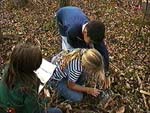
So why restore a graveyard? Many of us have
done a graveyard study, spent a few hours looking at dates and
inscriptions, making connections between families and death dates,
and maybe making a few rubbings. A restoration is doing those
things but is more ambitious.
For the past several years, we have increasingly looked for learning
opportunities in the community. Community-based curriculum has
some very positive aspects: a real world audience, potential for
making a real difference, assessment in a real way, awareness
of the gifted program in a positive light and, not the least,
a chance to make a contribution (often lasting) to the community.
The isolated graveyard we are currently working in is related
to another project in the community we have been working on for
ten years - an antebellum building on the National Register of
Historic Places.
It seems to us that the most relevant and powerful curricular
designs are those that have real world audiences. Projects and
products that are seen and, therefore, evaluated by persons outside
of the school environment are "authentic", much like
our current striving for better and more authentic assessment
measures. Restoring a burial ground to, as nearly as possible,
its original state can have an impact upon student and community.
And, quite possibly, beyond these curricular and learning considerations
is an outcome that is much larger. Louis Houck remarked in 1896
, "The culture, refinement, and in fact, the civilization
of a people can be measured by the respect paid its honored and
distinguished dead."
Pulaski County has many small and old cemeteries where this honor
is in evidence. It also has several where caring descendants are
either gone from the area or gone from the earth. These graveyards
have suffered years of neglect and are close to being beyond redemption.
It may not be any easy task to bring the sensitivity of Louis
Houck to an elementary or middle school student. It certainly
does not exist in many adults. but those things that are easy
are generally not worth their minimal effort.
Restoring a graveyard can offer learning opportunities that we
look for in educating gifted students. It has layers of learning
embedded in its complexity. Research in a variety of directions,
the mathematics of mapping, and opportunities for interpretation
and communication are a few possibilities. And there is something
to be said for the manual labor of cleaning stones and pulling
up encroaching vegetation.
A restoration project requires cooperation. Ah-cooperative learning
in a non-artificial situation. When working on a grave site, we
have two or three person crews to measure, decipher, and record
the information on an inventory form (see sample). The same team
approach is taken with cleaning stones. There certainly is no
competition, all stones not being created equal. Each marker has
its own requirements and needs.
You may think that such a project is not possible in your area,
that no such derelict yards exist. That is possible, although
it is more likely that you are not aware of them. We have seen
a nineteenth century German graveyard, with magnificently large
monuments, in shambles in a large metropolitan area. Within the
past few weeks, a community member led us to a family graveyard
on the edge of our town. It was small, overgrown, and the markers
toppled and broken. Here was the grave of one of our county's
most well-known Civil War era citizens, about whom a book had
been written, and yet no one has cared to provide minimal caretaking
of the yard. It is on public land. Our own first town cemetery
is badly in need of care. With some looking, the opportunity and,
most importantly, the need exists in all but the newest communities.

|
|
|
|
|
| Photographic Record |
|
|
|